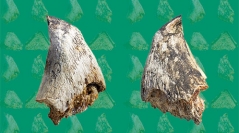

 Comptes Rendus Palevol
20 (27) - Pages 585-596
Comptes Rendus Palevol
20 (27) - Pages 585-596Teleostean evolution produced enormous variation in tooth morphology. This variation is related to the exploration and exploitation of very diverse dietary niches. Among extant fishes, several taxa of the order Tetraodontiformes (e.g. pufferfishes, porcupinefishes and ocean sunfishes) have evolved highly specialized beak-like tooth structures. Here we provide the first description of tetraodontiform crushing beaks from Argentina. A single complete premaxillary beak recovered from the early Miocene Gaiman Formation in Chubut Province is assigned to Molidae based on its premaxillaries being completely fused to one another along the midline, general morphology, and size. Moreover, due to the putative presence of rows of teeth fused to the thick and massive bone structure, the specimen might belong to the genus Ranzania Nardo, 1840. Several premaxillary beaks recovered in the late Miocene Paraná Formation of Entre Ríos Province are assigned to Tetraodontidae Bonaparte, 1832 based on the presence of long, slender, rod-like, and parallel dental units; premaxillae not fused in the midline but articulated by interlocking emarginations, and a few small and one large trituration dental units. Argentinian tetraodontiform fishes inhabited the warm-temperate Paranense and Patagoniense Seas (marine transgressions developed in southeastern South America) during the early-late Miocene; these specimens are the southernmost fossil record of the group worldwide. Tetraodontiforms are extremely rare in recent Argentinian marine waters. The new fossil records agree with the higher sea water surface temperatures suggested both locally and worldwide for the Miocene.
Beaked-dentition, Paraná Formation, Gaiman Formation, Southern Hemisphere